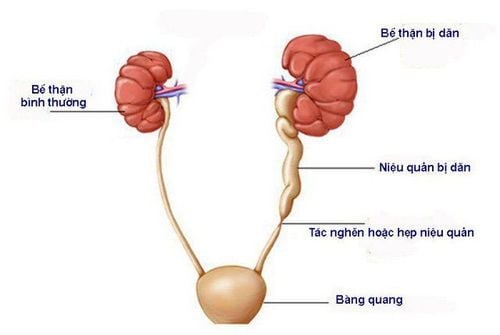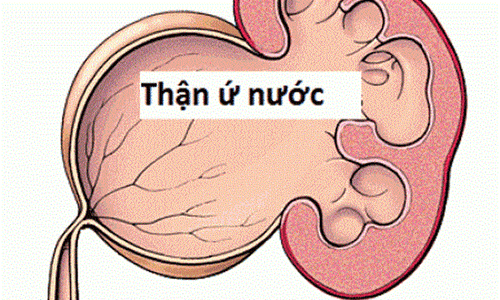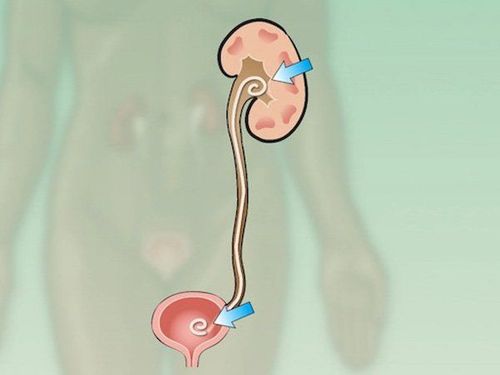This is an automatically translated article.
The article is professionally consulted by Master, Doctor Vo Thien Ngon - Department of General Surgery - Vinmec Da Nang International General Hospital
Currently, the method of shaping ureteral stricture is very interested and applied by hospitals. There are many methods of ureteroplasty that can endoscopically dilate the narrow segment and then connect the two ureters together, or connect the ureter directly to the kidney or down to the bladder.
1. What is ureteroscopy?
The ureter is a small tube, about 25-30cm long, responsible for carrying urine from the kidney to the bladder. The ureter can be narrowed due to infection, history of ureteroscopy, tumor of the ureter, or due to external compression due to tumor (cervical cancer, prostate cancer, rectal cancer .. .).According to biological structure, the ureter has 3 narrow places:
The ureter crosses the iliac artery and the part drains into the bladder. The junction between the renal pelvis and the ureter. Ureteral orifice: Pathological ureteral stenosis usually comes from a number of related diseases such as: Due to the tumor pressing on the ureter, congenital diseases, ureteral prolapse, narrowing of the ureteral junction or because Surgical interventions on the ureters,...
Ureteroplasty has many methods: It is possible to endoscopically dilate the narrow segment and then connect the two ureteral segments together, or connect the ureter directly to the kidney or down to the bladder .
2. In what cases is ureteroscopy indicated?
Congenital stenosis of the pyelonephritis-ureteral junction, stenosis of the pyelonephritis-ureteral junction due to vascular malformations. Narrowing of the pyelonephritis-ureteral junction due to complications after surgical intervention in the part of the ureter close to the renal pelvis, or in the renal pelvis... Urinary system malformations

3. Methods of shaping the ureter
3.1 Reconstruction by open surgical method Reconstruction of the ureter by open surgery method is to cut the narrow section and reconnect it. The main technical point is to cut off all the fibrous tissue, and reconnect without tension, so that the joint is wide. This method applies to short narrow 1-2 cm.
3.2 Endoscopic ureteroplasty Endoscopic ureteroscopy is a method of dilating the ureter by modern procedures.
Step 1: The doctor will administer general anesthesia or epidural and insert the ureteroscope through the urethra, bladder and up the ureter.
Step 2: Thanks to the signal camera system on the ureteroscope, the doctor can clearly observe the urethral lumen and the renal pelvis. Thanks to that, it is possible to diagnose diseases accurately and eliminate them more easily. In particular, the ureteroscope can provide special tools for stone removal, lithotripsy, ureteroscope incision or fragmentation.
Step 3: Place a J-shaped double-ended catheter (sonde JJ) from the renal pelvis through the ureter to the bladder to allow urine to drain from the kidney into the bladder. This step helps relieve blockage or narrowing of the ureter. Usually, the JJ tube does not interfere or affect the patient and is usually easily removed during cystoscopy 3 to 4 weeks later.
This is a gentle procedure, the operation only lasts about 30-60 minutes. The hospital stay is about 24-48 hours, depending on the degree of recovery. Patients can return to work 4 to 5 days after surgery and maintain a normal quality of life.

4. Notes after surgery
If you have open surgery, you should re-examine to remove the drain after 3 days and re-evaluate the wound. Before withdrawing the cystoscope to the skin, take an X-ray through the injection of contrast material into the bladder.
If there is no exit of contrast material and the suture sites heal, the urethral catheter can be removed and the bladder opener clamped to the skin. If the patient is able to urinate normally, the bladder can be withdrawn after 1 week. If all tubes have been withdrawn and there are no signs of infection, antibiotics can be stopped.
When experiencing unusual symptoms such as severe pain in the lower back spreading to the groin, scrotum, painful urination, blood in urine, frequent urination, etc., you must quickly go to a medical facility for immediate examination and treatment. Treat ureteral stricture by endoscopic ureteroscopy or medical treatment as soon as possible.
Patients with ureteroplasty can come to Vinmec International General Hospital for examination and treatment. There is a team of well-trained, professional and experienced gynecologists; system of modern equipment, meeting international standards; professional service quality, bringing satisfaction and comfort to customers.
Doctor Vo Thien Ngon has over 7 years of experience working as a urologist and surgeon at Hospitals: Hue Central Hospital, Hue University of Medicine and Pharmacy Hospital, Tam Tri Da Nang General Hospital .
Doctor Ngon with the ability to specialize in the field of examination and treatment of diseases of the Urology and Andrology system, Urology surgery, endoscopic urological surgery, Laparo urinary tract surgery, endoscopy Urinary. Currently, Doctor Vo Thien Ngon is a urologist - orthopedic surgeon, Department of General Surgery, Vinmec Danang International General Hospital
Please dial HOTLINE for more information or register for an appointment HERE. Download MyVinmec app to make appointments faster and to manage your bookings easily.














